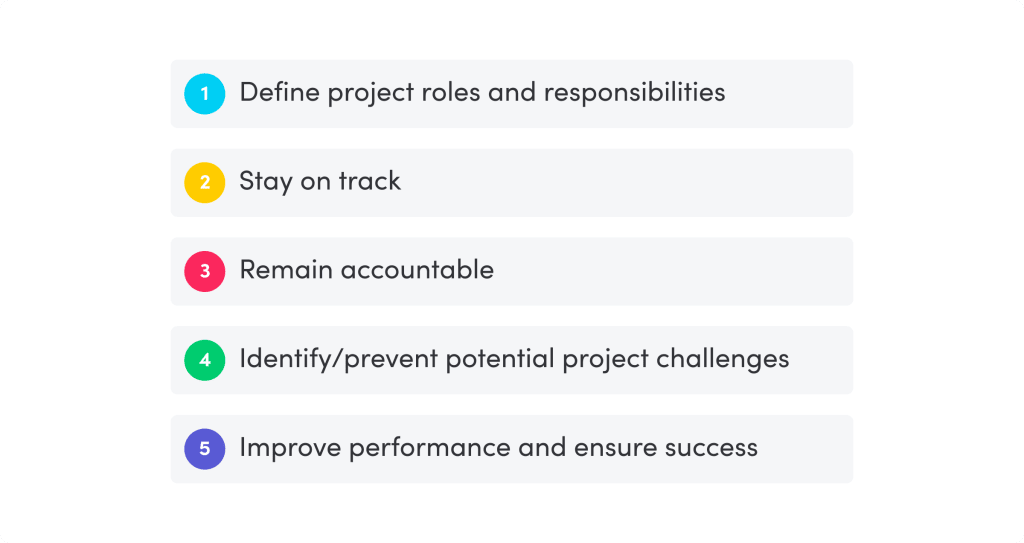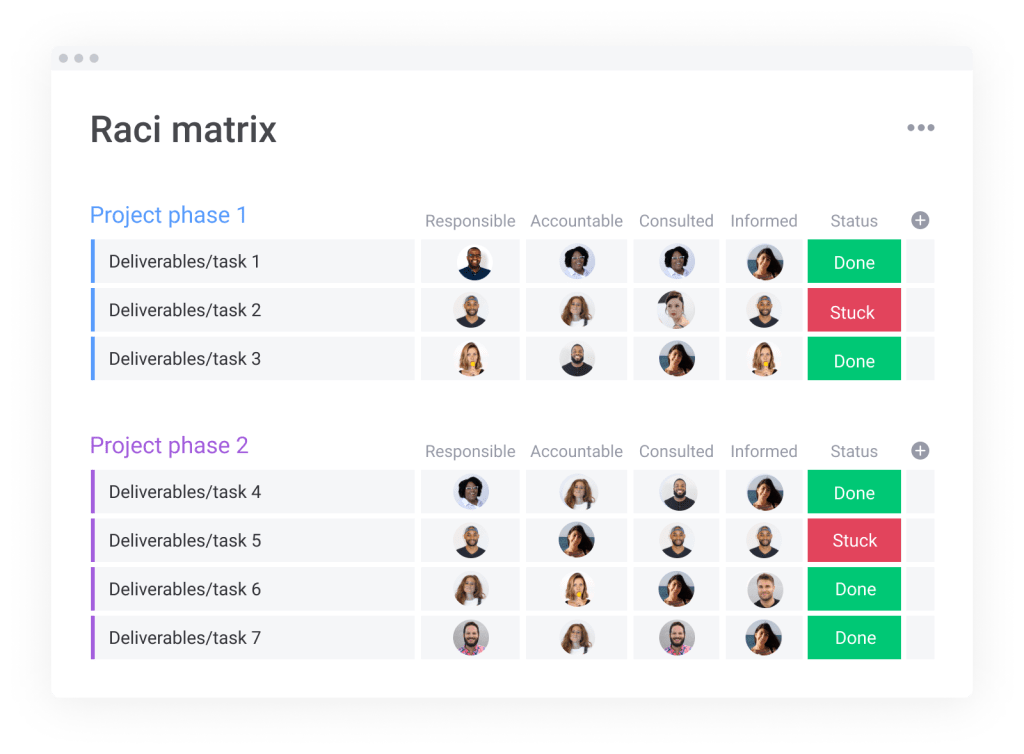It seems like there’s always a new fad or way to make teams more productive and efficient, so it’s hard to keep up with all the new matrices and methodologies out there.
With so many options out there, we’re here to eliminate confusion and help you make sense of how to optimize your workflows.
So, first things first:
What’s the meaning of RACI?
Responsible
Accountable
Consulted
Informed
RACI is an acronym used to describe the four key roles most often used to define and share team responsibilities.
RACI helps teams:

Or in more detail:
Responsible: the workers and/or stakeholders who actually do the work and complete the task at hand. This can be one individual or a group of people.
Accountable: the project owner, or maybe the multiple people who delegate the work, ultimately sign off when a task is complete are the ones who are accountable.
Consulted: this is a group of people who are “in the loop” and provide input along the way, but aren’t doing the work nor are they making key decisions. These individuals tend to be subject matter experts.
Informed: once a task or project is complete, this is the group of individuals who must be alerted. They can be informed in all sorts of ways, be it email or automatic notifications.
RACI is most often visualized using a model or matrix.
What is a RACI matrix?
A RACI matrix (sometimes called a RACI model or RACI Assignment Matrix) serves as a tool to help visually represent the various roles and responsibilities of a project.
Building out your matrix is as simple as completing the following four steps:
- Identify each stakeholder: list each stakeholder (project sponsor, team lead, team member 1, team member 2, etc) along the top of the matrix.
- Identify all tasks: list each task on the left side of the chart. Note: Depending on the complexity of your project, tasks may be high-level buckets and include several sub-tasks.
- Fill in the matrix: add a letter (or the full word) to each cell in the matrix. Responsible OR Accountable OR Consulted OR Informed. Note: In monday.com, each of the 4 words/letters can be color-coded for quicker identification.
- Clean up the matrix: every task/subtask must have at least one person responsible.
What are the benefits of using a RACI Matrix?
The proverb—too many cooks spoil the broth—is likely centuries old. However, Princeton University concluded it was true following their research into the ‘wisdom of crowds’.
You instinctively know when there are too many people getting involved in a specific task. It can even lead to conflict as each team member tries to exert an influence on tasks that shouldn’t need their input.
But without documented roles and responsibilities it’s harder to stop people from moving outside their lane and harming the smooth running of the project.
Using a RACI matrix helps to make sure that each task is only worked on by the right, relevant people.
Further benefits of using the RACI model are:
- It simplifies communication.
If only the right, relevant people are involved in a task, this streamlines communication making task completion more efficient.
- It prevents team member burnout.
Once you have drawn-up the RACI matrix, you’ll be able to see at-a-glance if any team member is overloaded with too many tasks on the project.
If your project has a single person shouldering most of the load, it creates a weak link that could spell disaster for the project if that person fails to deliver.
- It provides clarity of purpose.
Clarity of roles gives team members a purpose. If everyone can figure out immediately what they and others are doing using the RACI matrix, then this should result in a smoother workflow
Call a meeting for all the project’s stakeholders to produce a RACI matrix together, where you can get agreement on this new iteration of everyone’s roles and responsibilities.
Some examples of a RACI matrix in the real world
A RACI matrix sounds great in theory, but how do you apply it in the real world?
Here are a few examples:
Launching a new help page on your corporate website: ultimately, the design team would be Responsible for completing the work. The project manager would be Accountable for most of the tasks, which would be broken down one by one on the matrix. The head of customer support — whose team will be most directly impacted by the new help page — might be Consulted on the section’s contents And the marketing team would be Informed of the outcome so they could promote the new section.
Creating a new employee onboarding program: members of the human resources (HR) team would likely be Responsible for ensuring the work is done, while the director of HR would ultimately be Accountable for the final product. Each team lead would be Consulted as they’d wanted to ensure their team was represented in the training. Finally, members of the C-suite may want to be Informed about the final product.
The options are truly limitless!
How do you create a RACI Matrix?
At the most basic level, a RACI diagram is a simple grid you can set up in a spreadsheet.
Here are the seven steps for creating a RACI matrix.
- Start by making a list of the individual tasks you need to complete in order to successfully deliver your project.
- On a grid add the names of the stakeholders for the project (your team members) across the top as column headers.
- On the left of the grid add each task in its own row. You are now ready to add the project roles and responsibilities.
- Each task needs at least one stakeholder responsible for it. Add the letter ‘R’ where the person and the task intersect.
- Someone needs to be accountable for each task. Add an ‘A’ in the accountable person’s column. It can be the same as the stakeholder responsible.
- Add in any people that need to be consulted or informed as the task progresses using either ‘C’ or ‘I’ as applicable.
- When the matrix is complete and all project roles are set, get all the stakeholders to agree and sign off.
Or you can implement a RACI chart a bit more simply using monday.com’s RACI matrix template.

The monday.com template differs slightly from the method outlined above. The RACI roles become the column headers instead of team members, and people are inserted where the project task and responsibility intersect.
This allows you to fit in lots of team members while keeping the matrix manageable for display in your browser window.
You can also use monday.com’s super simple task management to split up your project into logical phases, so it’s easy to add in new tasks or even make several RACI matrices.
Next, customize your new template for your needs—add your action items, reorder based on priority, and create a tailored plan to fit your needs.
Finally, share your new RACI matrix with your team—assign team members to each action item and monitor your plan’s progress at every stage.
And, you are off!
Try it out for yourself for free for two weeks, no credit card required!


